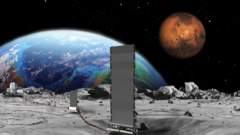NASA is pushing to implement a nuclear power source on the Moon by the year 2030, according to recent reports. This initiative is part of the United States' strategic effort to develop a permanent lunar settlement. The acting head of NASA highlighted the urgency of the situation due to similar ambitions from China and Russia, raising concerns that those countries might establish exclusive zones on the lunar surface. However, skepticism surrounds NASA's timeline given the agency’s recent budget cuts and ongoing shifts in space policy.
U.S. Transport Secretary Sean Duffy, currently leading NASA, emphasized the need for proposals from commercial entities to construct a reactor capable of generating at least 100 kilowatts of power. Although this is modest compared to traditional energy sources, such as wind turbines that produce multiple megawatts, the prospect of nuclear energy on the Moon is gaining traction. Previous contracts were awarded by NASA in 2022 for the design of such reactors, furthering the goal of continuous energy supply during the two-week lunar night.
Experts argue that solar energy alone cannot meet the demands of a lunar base, as the long periods of darkness would necessitate a reliable power strategy. Indeed, some scientists view nuclear power as not just advantageous, but a necessary step toward creating functional lunar habitats. Lionel Wilson of Lancaster University asserts that deploying nuclear reactors within the 2030 timeframe is technically feasible if sufficient funding is allocated.
Safety remains a paramount concern, particularly regarding the launch of radioactive materials from Earth. Dr. Simeon Barber, a planetary science expert, notes that despite safety regulations, launching nuclear elements poses significant challenges. This push from NASA comes in the wake of budget cuts, which have led to a reduction in many scientific programs aimed at advancing lunar exploration.
The announcement has sparked concerns regarding the potential for renewed competition in space exploration, reminiscent of the historical space race. Scientists like Dr. Barber worry that prioritizing national interests may overshadow collaborative efforts essential for unlocking the secrets of the solar system. In addition, the implications of claims to territory on the Moon—via the establishment of safety zones around nuclear facilities—could complicate international cooperation.
While NASA’s Artemis program aims to land humans on the Moon by 2027, hurdles such as funding uncertainties and recent setbacks raise doubts around the integration of nuclear technology into lunar missions. The apparent lack of cohesive planning poses additional challenges. As the race to the Moon intensifies, the question of lunar sovereignty looms large, positioning this initiative as a crucial element in the future of human space exploration.
U.S. Transport Secretary Sean Duffy, currently leading NASA, emphasized the need for proposals from commercial entities to construct a reactor capable of generating at least 100 kilowatts of power. Although this is modest compared to traditional energy sources, such as wind turbines that produce multiple megawatts, the prospect of nuclear energy on the Moon is gaining traction. Previous contracts were awarded by NASA in 2022 for the design of such reactors, furthering the goal of continuous energy supply during the two-week lunar night.
Experts argue that solar energy alone cannot meet the demands of a lunar base, as the long periods of darkness would necessitate a reliable power strategy. Indeed, some scientists view nuclear power as not just advantageous, but a necessary step toward creating functional lunar habitats. Lionel Wilson of Lancaster University asserts that deploying nuclear reactors within the 2030 timeframe is technically feasible if sufficient funding is allocated.
Safety remains a paramount concern, particularly regarding the launch of radioactive materials from Earth. Dr. Simeon Barber, a planetary science expert, notes that despite safety regulations, launching nuclear elements poses significant challenges. This push from NASA comes in the wake of budget cuts, which have led to a reduction in many scientific programs aimed at advancing lunar exploration.
The announcement has sparked concerns regarding the potential for renewed competition in space exploration, reminiscent of the historical space race. Scientists like Dr. Barber worry that prioritizing national interests may overshadow collaborative efforts essential for unlocking the secrets of the solar system. In addition, the implications of claims to territory on the Moon—via the establishment of safety zones around nuclear facilities—could complicate international cooperation.
While NASA’s Artemis program aims to land humans on the Moon by 2027, hurdles such as funding uncertainties and recent setbacks raise doubts around the integration of nuclear technology into lunar missions. The apparent lack of cohesive planning poses additional challenges. As the race to the Moon intensifies, the question of lunar sovereignty looms large, positioning this initiative as a crucial element in the future of human space exploration.




















